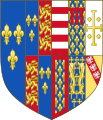Файл:Arms of Margaret of Anjou.svg
 Из Википедии, бесплатной энциклопедии
Из Википедии, бесплатной энциклопедии

Исходный файл (SVG-файл, номинально 408 × 477 пкс, размер файла: 1,41 МБ)
История файла
Нажмите на дату/время, чтобы посмотреть файл, который был загружен в тот момент.
| Дата/время | Миниатюра | Размеры | Участник | Примечание | |
|---|---|---|---|---|---|
| текущий | 06:05, 19 февраля 2015 |  | 408 × 477 (1,41 МБ) | Sodacan | fix Bar quarter |
| 11:56, 5 августа 2013 |  | 408 × 477 (1,43 МБ) | Sodacan | size | |
| 11:28, 5 августа 2013 |  | 408 × 465 (1,43 МБ) | Sodacan | sizing | |
| 07:47, 16 июля 2013 |  | 436 × 465 (1,45 МБ) | Sodacan | User created page with UploadWizard |
Использование файла
Следующие 4 страницы используют этот файл:
Глобальное использование файла
Данный файл используется в следующих вики:
- Использование в af.wikipedia.org
- Использование в ar.wikipedia.org
- Использование в arz.wikipedia.org
- Использование в ast.wikipedia.org
- Использование в azb.wikipedia.org
- Использование в be.wikipedia.org
- Использование в bg.wikipedia.org
- Использование в ca.wikipedia.org
- Использование в cs.wikipedia.org
- Использование в da.wikipedia.org
- Использование в de.wikipedia.org
- Использование в el.wikipedia.org
- Использование в en.wikipedia.org
- Использование в eo.wikipedia.org
- Использование в es.wikipedia.org
- Использование в eu.wikipedia.org
- Использование в fa.wikipedia.org
- Использование в fr.wikipedia.org
Просмотреть глобальное использование этого файла.